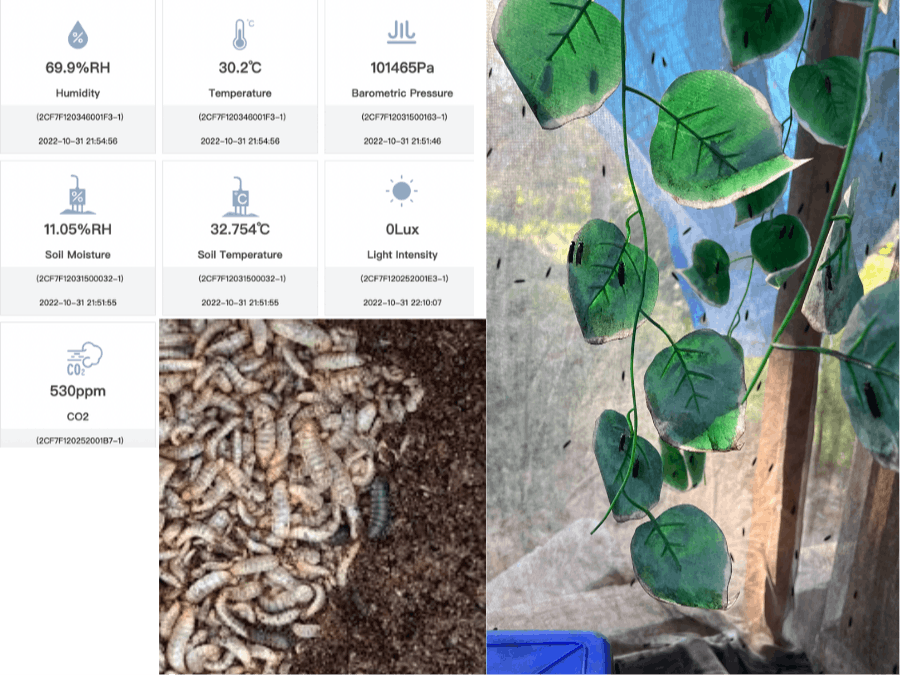In our previous project, we began by understanding what black soldier fly farming is all about, the market dynamics and demand as well as how relevant factors including temperature, humidity, light intensity and more impact the behaviour as well as growth of the BSF's.
We are grateful to Seeed Studio for giving us the opportunity by winning the award as well as the SenseCAP K1100 kit that enabled us to explore and attain more information on this project. You can find more information on our project and the details below:
What's next?:This time, we focused our efforts in deploying sensors in the environment, where we were able to let our BSF pupa ready to fly!
ThePreparation Process:
1. The Setup: We built a shed that would hold five "love nests" in which we would place our pupas. The build took approximately a week to ensure everything was secured and well laid out
2. Inside the Love Nests: We usually call them love nests because of the mating habits the flies tend to have. Inside the love nest you will find the following:
- The trays consisting of the pupa covered, because they tend to pupate in darkness, hence we cover them but allow some space for air flow
- A bowl containing a sponge soaked in water and glucose, since the flies dont feed on any solid food/waste rather depend on water only
- A bowl consisting of the substrate ( mixture of fish guts ), with a strong smell as an attractant to allow the flies to mate and lay their eggs on the wooden planks above the bowl.
- The wooden planks placed above the substrate/attractant would serve as an area for the flies to lay their eggs carefully. It is important to ensure the gap between the wooden planks is just a few millimetres. Anything more or less would prevent them from laying their eggs within the intended area leading to catastrophe.
- Some greenery to make them feel homely. It is recommended to have a few plants so that they feel cosy and more "in the environment" rather than caged up per say
3. Outside the Love Nests: We need to ensure that we dont have any insect or bugs crawling into the nest, especially ants, who tend to be the biggest thieves carrying away the eggs! Hence, we usually ensure the legs are placed under bowls of water or used oil/grease preventing anything from crawling up
- The Black Soldier Flies tend to have a really short life span (between 11-14) days
- The male would usually die a few hours later after mating with the female
- The female would lay between 70-100 eggs approximately, after which she would eventually follow the same fate as the male towards death
Things get interesting here. Let me take you through the process from the time you introduce the pupa into the love nest, all the way to egg harvest and repeating the cycle.
Note 1: The larva change in colour as they grow right from when they begin moving all the way to pupation. From small and white, all they way to golden-yellow, eventually to brown and finally black, where they eventually fold up into pupa. Farmers tend to harvest at the golden yellow stage, which is defined as the optimal grade of protein the larva, of which 70% is dried and grind into powder, while 30% is kept back to allow them to go back to flies in the nests.
Day 1 - 5: Introduce the pupa into the nest, keep them covered as mentioned earlier so that they begin hatching and flying
Day 6: You will begin seeing a lot of the flies around the nest, this is the time where you introduce the soaked sponge and attractant. From this day, you will count approximately 4 days after which you will harvest your first batch of eggs.
Depending on the weather, keep spraying externally on the nests the water-glucose mixture to ensure the area is cool at the same time they are able to attain water just in case, twice- thrice a day.
Day 10: Remove the wooden planks, prepare your tray of moist grind cob corn, gently scrap the eggs into the tray and eventually cover them. After 3-4 days, you will begin seeing little larva begin moving around. No feeding takes place at this point, instead we just ensure the mix is moist enough. Wait for another 3-4 days before introducing the food waste. Repeat this process after another 5-6 days to obtain the second harvest and another 4-5 days after the second harvest to obtain the third harvest.
Note 2:Usually the first harvest tends to have the most eggs, while the second harvest would have slightly less and if you're lucky for a third then why not( but rare ) !
Day 14: Feeding Time: We will prepare a separate tray that would contain a balanced mix between the organic food waste and the grind corn cob, this is because the organic food waste tends to be really wet and wouldnt be ideal for the larva, hence the grind corn cob serves the purpose as a drying agent. The best mix need not be too dry nor too wet, just enough to ensure its balanced well. We would use two full hands of larva and transfer them into the set food trays until the tray holding the larva is emptied. This would be done similarly for the other harvests.
Day 15- 25: Monitor/ Harvest/ Feed: This is a little crucial in the sense that we need to ensure the larva are growing at the same time food is being consumed. Once you notice the colour change, as mentioned earlier, part of the larva are turned into protein powder while remaining continue growing and changing colour towards pupa. If they larva continue eating then add some food mix at a small amount, observing the colour change such that at the point of brown-black, they WILL NOT be eating anymore instead prepare for pupation.
Day 28-30: Back to the Nest: You will begin noticing that majority are brown/black, while those that are black some may not be moving but rather already in pupation stage and need to be moved back into the nests.
The sensors used:Note 3: You can visit the seeed studio website and access the quick guide on how to connect your SenseCAP sensors to your LoRaWAN gateway
1.Air Temperature and Humidity: The ideal temperature needed is between 26-29 deg C and as for the humidity atleast 55-60%. If it gets too hot, we usually pour water on the floor which will help with cooling and if it gets cooler than required, this may lead to no mating hence we would to use strong attractants and replace frequently, but also use warm lights inside the nests
2. Soil Moisture and Temperature: The trays consisting of the larva needs to be monitored carefully, as we did so in the previous project (link above). They usually generate a lot of heat when they move and at the same time making their environment loose moisture. At the same time, since they are not fans of light as much, they tend to bury under which depletes the amount of oxygen they need. Hence we need to ensure that we pick them up and spread them to allow air flow and heat dissipation, as well as spray some water on them to keep it cool and moist
3. Light Intensity: The amount of sunlight the flies get is very important. No sunlight, no mating which means no eggs and hence we have a problem. Hence the sensor tells us how much light is entering the setup to ensure it is optimal at all times.
Other Products/Outcomes from the project:1. Organic Compost: Once we the flies die in the nest, what remains is compost which can be used as organic fertiliser. From our tests, we have been able to yield healthy spinach with our students.
2. Remaining Flies: The dead flies too can be consumed by the chicken as feed which also is useful.
1. Weather: The cool weathers gives us a challenge such that we need to ensure the attractant is always having a strong smell, yet there are times despite the efforts we yield very little eggs
2. Electricity: We tend to face a lot of power shortages, hence monitoring over the air can be challenging. This becomes worrying hence need to rush back to the lab when I'm running errands
Biggest Achievements:By far, the best part about this is having this project shared with community members from different areas within the region. Their disbelief and shock at us farming flies has been really funny but overall, they have really found this project fascinating and now are willing to form community youth groups to access loans from the city council to begin setting up their own farms. This is huge! We have had over 200 people visit us this far and cant wait to have more!
To Diana, Otiago, Eno from Novfeed Team, my amazing students for their tireless efforts in building, maintaining and learning endlessly failure upon failure. And a huge shoutout to the Seeed Team for the parts and support!
















Comments
Please log in or sign up to comment.